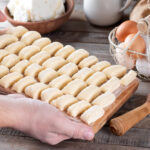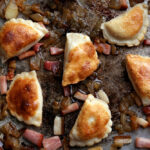Few dishes capture the essence of Polish cuisine quite like pierogi. These delightful dumplings, often crescent-shaped, are pockets of dough filled with a seemingly endless variety of savory or sweet ingredients. They’re a staple on Polish tables, evoking feelings of home, tradition, and celebration. Pierogi are more than just food; they’re a cultural icon.
What are Pierogi?
Pierogi are traditional Polish dumplings that hold a special place in the heart of Polish cuisine. These delightful pockets of dough are typically filled with a variety of ingredients, ranging from savory to sweet. The dough itself is made from a simple mixture of flour, water, and eggs, creating a soft and pliable base that can be easily shaped and filled.
Once filled, pierogi are usually boiled until they float to the surface, signaling that they are cooked through. For an added layer of flavor and texture, many people choose to pan fry their pierogi in melted butter until they achieve a golden-brown crust. This method not only enhances the taste but also adds a delightful crunch.
Pierogi are often served with a variety of toppings that complement their rich flavors. Sour cream is a classic choice, providing a tangy contrast to the savory fillings. Caramelized onions, with their sweet and savory notes, are another popular topping that adds depth to the dish. Whether enjoyed as a main course or a side dish, pierogi are a versatile and beloved staple in Polish cuisine.
Unpacking the Cheesy Delight: Cheese-Filled Pierogi
While pierogi come with many fillings, this blog post focuses on the beloved cheese-filled variety. We’ll explore the types of cheese used, traditional recipes, creative variations, and the cultural significance of this comforting dish. Farmer’s cheese is particularly important in traditional Polish pierogi, known for its unique flavor and versatility in various culinary uses.
The Cheese: The Heart of the Matter
The type of cheese defines the character of cheese pierogi. There’s a key difference between traditional Polish versions and those popular in North America.
Traditional Polish Pierogi: The star here is twaróg, also known as farmer’s cheese. Twaróg is a fresh, slightly sour cheese, similar to quark. It provides an authentic, tangy flavor that’s deeply rooted in Polish culinary heritage. Farmer’s cheese is made by draining whey from cottage cheese, resulting in a solid form that can be substituted with other cheeses like ricotta or twaróg. A great thing about twaróg is that you can freeze it. The texture might change a bit, but it remains perfectly good for pierogi fillings.
North American Adaptations: In Polish communities across North America, cheddar cheese often finds its way into pierogi fillings. This variation, with a history spanning over 70 years, has become a tradition in its own right. Cheddar offers a sharper, more familiar flavor for many.
Other cheeses can also be used:
- Ricotta cheese: A soft cheese that provide creamy texture.
- Paneer: A fresh cheese, often used in South Asian cooking. It is a good substitute for farmer’s cheese.
- Dry curd cottage cheese: Cottage cheese with most of the whey removed. It offers a drier texture.
The Perfect Pierogi Dough: Simple Yet Crucial
The dough is the foundation of any great pierogi. While the ingredient list is short, precision is key.
A standard recipe combines flour, salt, sour cream, eggs, melted butter, and vegetable oil. The type of flour matters. For a softer, more translucent dough, use extra-fine flour like Polish tortowa flour or Italian 00 flour.
Measuring the flour accurately is vital. Always scoop the flour into the measuring cup. Do not dip the cup into the flour bag. Dipping can pack too much flour in, resulting in a dry dough. After mixing, let the dough rest, covered, for 15-20 minutes. This makes it easier to roll and shape.
Homemade Pierogi Dough Recipe
Creating homemade pierogi dough is a straightforward process that requires just a few basic ingredients. Here’s a simple recipe to get you started:
Ingredients:
- 2 cups all-purpose flour
- 1/2 cup warm water
- 1/4 teaspoon salt
- 1 egg, beaten
- 1 tablespoon vegetable oil
Instructions:
- In a large mixing bowl, combine the flour, warm water, and salt. Mix until a dough forms.
- Add the beaten egg and vegetable oil, then mix until the dough is smooth and elastic.
- Transfer the dough to a floured surface and knead for about 5 minutes, until it becomes smooth and pliable.
- Cover the dough with plastic wrap and let it rest for at least 30 minutes. This resting period is crucial as it allows the dough to relax, making it easier to roll out.
- Once rested, divide the dough into smaller pieces. Roll out each piece into a thin circle on a floured surface.
- Use a glass or a pierogi cutter to cut out circles of dough, ready to be filled with your favorite ingredients.
This soft dough is the perfect canvas for a variety of fillings, ensuring that each pierogi is a delicious bite of Polish tradition.
Traditional Cottage Cheese Filling Recipes: A Taste of Poland
Traditional Polish cheese pierogi fillings are often simple, focusing on the quality of the ingredients.
One classic recipe combines farmer’s cheese with mashed potatoes and sautéed onions. Leftover mashed potatoes can be an ideal ingredient for making classic pierogi, transforming plain leftovers into a delicious treat. The tanginess of the cheese, the richness of the potatoes, and the sweetness of the onions create a perfect balance. Another traditional approach uses Velveeta cheese and potatoes for an exceptionally creamy filling.
Managing moisture is crucial. Use dry curd cottage cheese, or make sure your potatoes are very dry after boiling. This prevents a soggy filling and helps the pierogi hold their shape. Gather the remaining dough scraps after cutting rounds and cover them for later use.
Types of Pierogi Fillings
The beauty of pierogi lies in their versatility. There are countless types of fillings that can be used, each bringing its own unique flavor and texture to the table. Here are some popular options:
- Potato and Cheese: A classic filling made with mashed potatoes and cheese. The creamy texture of the mashed potatoes pairs perfectly with the tangy flavor of the cheese, creating a comforting and satisfying bite.
- Cheese: A simple yet delicious filling made with farmer’s cheese or cottage cheese. The slightly tangy and creamy cheese filling is a favorite among many.
- Meat: A hearty filling made with ground meat, such as pork or beef. This savory option is perfect for those who enjoy a more substantial pierogi.
- Vegetable: A filling made with sautéed vegetables, such as onions and mushrooms. This vegetarian option is both flavorful and nutritious.
- Fruit: A sweet filling made with fruit, such as strawberries or blueberries. These dessert pierogi are often enjoyed with a sprinkle of powdered sugar or a dollop of whipped cream.
Each type of filling offers a different taste experience, making pierogi a versatile dish that can be tailored to suit any preference.
Variations on a Theme: Exploring Cheese Pierogi Possibilities
Tradition is wonderful, but there’s always room for creativity!
Sweet Cheese Pierogi (Pierogi z Serem or Pierogi z Serem na Słodko): These are often enjoyed as a dessert. They feature a lightly sweetened farmer’s cheese filling, often with a hint of vanilla. Using a food processor ensures a perfectly smooth filling. Adding semolina and cornstarch/cornflour helps bind the filling and creates a smoother texture.
Savory Variations: The possibilities are endless! Consider:
- Spinach and feta
- Sauerkraut and mushroom
- Potato and cheddar with Italian herbs
- Even blood sausage (kaszanka) for a truly unique flavor!
Tips for Filling Perfection
Here are some tips to ensure your cheese filling is exceptional:
- Consistency: The filling should be moist, but not watery. This is especially important with potato fillings. Excess moisture can make the pierogi break during cooking. Make sure potatoes are well-dried or riced. Dry curd cottage cheese is also helpful.
- Flavor Combinations: Experiment! Sautéed onions are a classic addition. Herbs like dill or chives add freshness. Spices like black pepper or cayenne provide a little heat.
- Temperature: Let the filling cool before filling the dough. This prevents it from becoming runny and makes assembly much easier.
Pierogi’s Place in Polish Culture
Cheese pierogi are deeply ingrained in Polish culinary traditions. They’re often seen as comfort food, associated with family and home. Their versatility means they’re suitable for everyday meals and special occasions. In some areas, cheese pierogi are a summer main course.
The history of pierogi might extend beyond Poland. Some believe they originated in China and reached Europe via the Silk Road. This highlights the fascinating way culinary traditions can blend and evolve.
Pierogi are similar to other dumplings around the world, like Chinese jiaozi and Italian tortellini. These dishes, while distinct, share the common concept of filled dough.
The popularity of “pierogi ruskie” (potato and cheese pierogi) shows the historical link between Polish and Ukrainian cuisine. This simple, satisfying dish symbolizes shared culinary heritage.
Pierogi are also important during Polish holidays. They represent family unity and are often part of the traditional twelve-dish Christmas Eve meal.
Cooking and Serving Your Masterpieces
Typically, pierogi are boiled in salted water until they float (about 5 minutes). But, they can also be baked or deep-fried for a different texture.
Serving Suggestions:
Savory:
- Melted butter and fried onions
- Sour cream and bacon bits
- Smoked sausages or sautéed mushrooms
- A crunchy vegetable salad
Sweet:
- Powdered sugar or cinnamon
- Fruit compote or apple puree
- Whipped cream or ice cream
Storing and Freezing Pierogi
Pierogi are a great make-ahead dish, as they can be stored in the refrigerator or freezer for later use. Here’s how to store and freeze your pierogi to maintain their quality:
Refrigerating Pierogi:
- Place the pierogi in a single layer on a baking sheet lined with parchment paper.
- Cover with plastic wrap and store in the refrigerator for up to 3 days.
Freezing Pierogi:
- Arrange the pierogi in a single layer on a baking sheet lined with parchment paper.
- Freeze until solid, then transfer the frozen pierogi to a freezer-safe bag or container.
- Store in the freezer for up to 3 months.
Cooking Frozen Pierogi:
- To cook frozen pierogi, simply boil them in water until they float to the surface.
- For added flavor, pan fry the boiled pierogi in butter until they are golden brown and crispy.
By following these storage tips, you can enjoy delicious pierogi anytime, whether you’re preparing a quick weeknight meal or planning a special occasion.
A Delicious Conclusion and an Invitation
Cheese-filled pierogi offer a delightful taste of Polish cuisine. The filling choice from traditional farmer’s cheese to cheddar, ricotta, and paneer affect the pierogi’s character. Consistency, and balanced flavors are also important.
Pierogi are more than food. They represent Polish culture, comfort, family, and tradition. Pierogi work for everyday meals and holidays. Their popularity show how versatile and loved they are. Cheese pierogi, with sour cream and bacon or fruit and cinnamon, introduce people to Polish culinary heritage.
Ready to experience the authentic taste of Polish pierogi? You can buy pierogi online at Polka-Deli.com and enjoy this delicious tradition in your own home!









